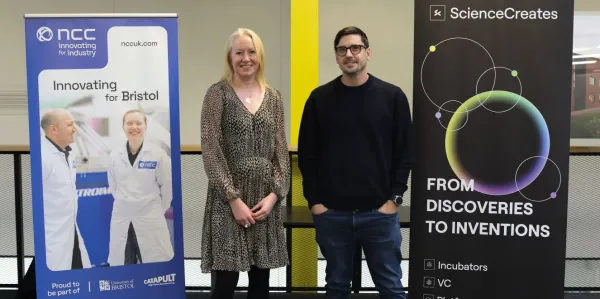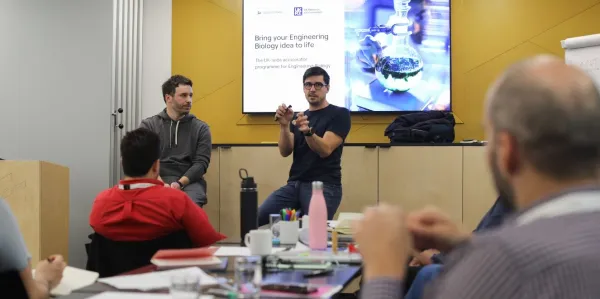We need a healthcare revolution - and we need it now
Our methods of diagnosing disease are fundamentally flawed, and ever-smarter bacteria are triggering a crisis of global warming proportions. What can we do to keep our healthcare system healthy?

Our methods of diagnosing disease are fundamentally flawed, and ever-smarter bacteria are triggering a crisis of global warming proportions. What can we do to keep our healthcare system healthy?
By Nicky Jenner, Science Editor

It’s never a welcome scene: you wake up feverish, with a throat like cut glass. Exhausted and thoroughly under the weather, you drag yourself to your doctor’s surgery, where the GP diagnoses you with strep throat and prescribes you some antibiotics. It’s a miserable morning, you tell yourself, but at least you’ll soon be feeling better — right?
Actually, maybe not. While once a reliable method of treating bacterial infection, antibiotics are becoming less and less likely to work.
In the UK, there’s a 20% chance that the firstchoice antibiotic the doctor gives you won’t work, and this figure is even more worrying elsewhere. In China, it sits at around 50%, with Shanghai standing out as a resistance hotspot at 80%. In a modern healthcare system like ours, this seems unbelievable: that if you head to the doctor in Beijing with strep throat, there’s only a 50:50 chance you’ll be given effective medicine. How did we get here?
“The first antibiotic, penicillin, was discovered in 1929, after which we discovered loads more that all worked well and let us treat bacterial infections pretty effectively”, explains Michael Roberts, Founder and CEO of GenomeKey, a transformative diagnostics company based in Bristol. “But then we started to realise that bacteria were evolving and finding ways to get round our antibiotics.
“This resistance is the ‘other’ global warming: another sort of existential threat facing humankind.”
While it may ‘only’ be a 20% problem today in the UK, it’s worsening. “I can’t say how long it’s going to take us to get to 40%, 60%, maybe even a Shanghai-like 80%, but I can tell you that it’s happening”, says Michael. “So we’re building tools today in preparation for that future — tools that doctors desperately need to match the right treatments to the right patients.”
Throw everything, see what sticks
To make a diagnosis today for an infection such as sepsis or meningitis, doctors take a blood sample and send it off to the lab, where the sample is put into an incubator to see what bacteria grow (a process called blood culturing). Then, it’s a waiting game. Doctors can’t do anything without knowing what the Nicky Jenner, Science Editor problem is, so the patient is left twiddling their thumbs and feeling rotten. It’s an expensive, days-long process that isn’t just inconvenient — it can be deadly. For fast-acting and life-threatening diseases, a patient could die before their results arrive.
“Culturing is the problem. It’s a slow and fundamentally flawed approach to diagnosing disease”, says Michael. “So what we’re saying is: let’s try and go about it a different way.”
To Michael and GenomeKey, “a different way” takes the form of a tool that can skip the blood culturing step by instead hunting for and profiling any bacterial DNA present within your blood. Think back to the hypothetical morning when you head to the doctor for treatment. Instead of sending a vial of your blood to the lab for a few days, this time your doctor whips out a futuristic handheld device. They take your sample, insert it into the machine, and let the high-tech scanner work its magic. After mere hours, not days, the machine pings — the results are in, and the doctor can now choose the most appropriate treatment for you.
Crucially, analysing a bacterium’s DNA not only tells you its type but also what it’s resistant to — the key information clinicians need to quickly select the right antibiotic. “If you put someone on the right antibiotic much earlier, you could just be saving their life”, adds Michael. “You also have a good chance of reducing the cost of infection and preventing the overuse of antibiotics, because you can use a much smaller amount much earlier on — very precise and targeted antibiotics, rather than throwing the whole spectrum at people to see what works.”
Scanning your body’s blueprint
Handheld health scanners may sound like something from science fiction, but it’s where our healthcare system is headed: towards tools that can rapidly read the complicated biochemistry of your body and print out useful information at the point of care (while you’re actually sat with your doctor, not several days later).
“You don’t want a multi-million-dollar device in a lab run by just a few specialised scientists”, says Andy Heron. “You want something like a tricorder from Star Trek: something you can just take out and measure the things you want to measure, right there and then.”
A recent example of the value of rapid point-of-care testing is at-home COVID-19 testing, which provided governments with the vital information needed to manage the coronavirus pandemic.
Andy is the Founder and CEO of Portal Biotech, a company developing a new device to monitor, measure and detect the proteins and small molecules associated with disease. “Everything from standard day-to-day health and wellbeing to every single disease: it’s all captured in the proteins and molecules”, says Andy.
Past decades have brought about a revolution in our ability to measure and map our genetic code. We can now sequence a complete human genome in a single day for around £500, something that’s been a complete game-changer for the healthcare industry. However, advances in our understanding of proteins (proteomics) are comparatively lacking, and growing more and more important given that the vast majority of drugs target proteins.
According to many healthcare innovators, what we need now is a similar revolution for the next layer down: the proteins created by your DNA, rather than your DNA itself.
“You can understand a lot of disease by understanding the genetic code, but there’s a lot that’s much more difficult to understand without knowing what’s happening to proteins”, says Andy. “The classic example of where DNA falls down is that of identical twins — they share identical DNA, but they have entirely different lives and health outcomes, because what makes you ‘you’ on a day-to-day basis isn’t your genetic code but how your environment interacts with that over time.
“Another classic example is a caterpillar and a butterfly: it’s the same underlying genetics, but the functional biochemistry is obviously entirely different.”
Portal Biotech aren’t the only ones focusing on a ‘protein revolution’ for detecting disease. Another company, Rosa Biotech*, has a different approach to picking apart complicated biological mixtures, instead employing novel lab-built proteins as disease detectors. The team loads up lots of barrelshaped proteins with special dyes, and then expose them to something — a patient sample — they want to analyse. Different molecules dislodge the dyes in different ways, creating distinctive coloured patterns that reveal what’s lurking inside the mix.
Caterpillar vs. butterfly
The aforementioned revolution in genetic scanning and sequencing has made the idea of personalised or precision medicine — medicine designed to suit your specific genetics, biochemistry and life experience, rather than being applied generically — a real possibility.
In the UK, some new parents may soon be offered the ultimate tool in personalised medicine: optional genomic sequencing for their babies at birth, so that scientists can spot early signs that intervention could help improve the baby’s future health.
While humans share the same broad biochemistry and so many drugs work universally across populations, many health problems relate to highly specific mechanisms of disease, and so would be most effectively treated with highly specific treatments that are tailored to the patient.
“We’re effectively in the era of personalised medicine already, and it’s certainly where medicine needs to go”, concludes Andy. “You want to measure people as individuals, so we can confidently say: ‘Yes, this is the right medicine for you’. It’s about measuring the detail and complexity of your genes, your proteins, to really unlock the differences between individuals — the differences between a caterpillar and a butterfly.”
Bloodborne bio-machines
Tricorder-like devices are an exciting example of science fiction leaping off the small screen and into the lab — but what if we could go a step further and redesign the body to heal itself, an enviable talent showcased by Schwarzenegger’s cyborg Terminator?

Cell therapy company Scarlet Therapeutics has zeroed in on the potential of our blood for targeted healing, and is generating therapeutic red blood cells in the lab. “The main function of red blood cells is to carry oxygen around the body”, says Alistair Irvine, CEO of Scarlet Therapeutics. “But if you can make them do something of therapeutic benefit as well, you essentially create little bio-machines working away to deliver drugs or perform a treatment within your body. For example, if you’ve got a patient with a genetic condition that causes toxins to build up in their system, they’ve got no way of getting rid of those toxins — but we can create and infuse red blood cells that break them down.”
Non-modified universal red blood cells can also be created in the lab, a possibly lifesaving prospect for patients with rare blood types needing transfusions.
Scarlet Therapeutics creates synthetic cells by taking a blood sample from a donor, and genetically modifying special constituent cells so that they grow into red blood cells containing a protein, or proteins, of choice. These special constituent cells are known as stem cells, and have the unique ability to grow into many of the different cell types found in the human body. Stem cells play a crucial role in cell therapy, a huge and rapidly growing area of healthcare. Therapies are being developed for a wide range of conditions including autoimmune disease, cancers, dementia and paralysis.
“The really exciting part of what we’re doing is generating a cell line: a population of cells that can be kept alive in the lab for a long period of time. You basically take the initial cells and make them immortal”, adds Alistair. “You can create a continual supply of therapeutic blood, so you don’t have to go back to the donor every time. If you build the line from someone whose blood is compatible with the majority of people, you can treat most patients with blood from a single cell line — the end goal is to get red blood cells that can go into anybody. Overall, lab-grown cells will play an important role in the healthcare system of the future.”
*Rosa Biotech ceased operations in 2024
Continue reading Gravitate - The Deep Tech Founder Magazine






